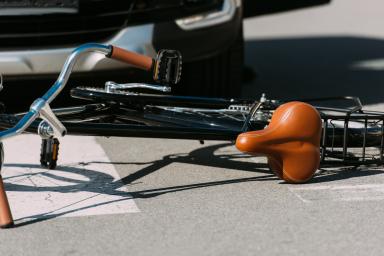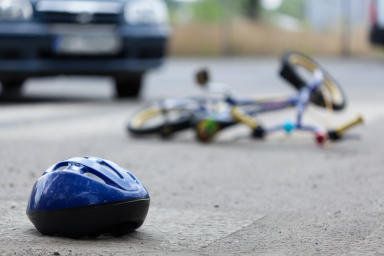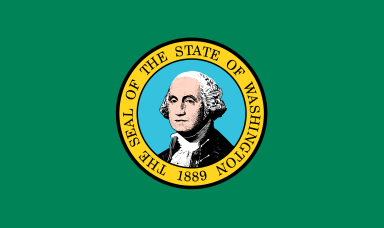How Do Traffic Laws Apply to Bicycles?

Riding a bicycle is a great way to get around and stay in shape. It can be an effective way to save money on gas and the other costs that come with owning a motorized vehicle. However, one of the downsides of riding a bike is that you will have to share the road with other motorists. According to the CDC, nearly 1,000 bicyclists die every year, and over 130,000 are injured in crashes that occur on the road. The result is a cost of over $23 billion every year in injuries and deaths. This includes the money spent on health care, loss of quality of life, funeral costs, and lost wages. While accidents may not be entirely preventable, following the rules of the road can help prevent dangerous crashes and injuries. In this article, you will find information about the laws that are applicable to both motorists and bicyclists who share the road, along with legal resources to help victims of bike accidents.
Drive on the Right Side of the Road
Bicyclists must ride with the traffic flow on the right-hand side of the road. This means they should ride as close to the right-hand edge of the road as is safe, except when turning left, passing another bicyclist, or avoiding an obstacle. Bicyclists must use designated bike lanes and paths when available unless it is unsafe to do so. If there is no designated bike lane, bicyclists should ride as far to the right as practicable. Many states have laws that require slower vehicles to maintain their position in the furthest right lane if it is a multi-lane road. This also applies to bicyclists, typically the slowest vehicles on the road.
Yielding When Changing Lanes
This can also be known as the “first come, first serve” rule. If you’re driving a car and want to change or merge lanes, you must yield space to drivers who were there before you. It remains the same for bicyclists. When bicyclists share the road with other vehicles, they must remember that they have space just like other drivers. If there is a situation where a bicyclist has to switch lanes and merge, they have to remember the rules of the road when doing so. The rider must signal (more on that later), check their blind spots, yield space to other vehicles if necessary, and then safely perform the lane change or merge. Since bicyclists are also entitled to their own space, motor vehicle drivers must yield to them to prevent an accident.
Lighting at Night
As drivers on the road, visibility is critical during the night time. Once the sun goes down, vehicles must have their lights on for their own safety as well as the safety of everyone else on the road. For bicyclists who enjoy riding at night, it is much the same. Bicyclists must use lights and reflectors when riding at night or in low-light conditions. A white front light and a red rear reflector are required by law in most places. Most bicyclists will use an LED light that is bright and has blinking functions to make themselves stand out more and be more visible to all drivers at night.
Yielding to Crossing Traffic
Bicyclists must yield to pedestrians on sidewalks and crosswalks, just like other vehicular drivers have to. When approaching an intersection with pedestrians on the sidewalk, bicyclists should slow down and give pedestrians plenty of space to cross the road. Bicyclists should also acknowledge other vehicles on the road crossing and have the right of way. Many accidents involving cyclists and vehicles happen due to one of the operators not acknowledging the right of way of the other. When riding your bike, you should follow all traffic signs and lights on the road as you would when driving a vehicle.
Following Lights and Traffic Signs
Bicyclists must obey traffic signals and signs, just like drivers of motor vehicles. When motor vehicle drivers do not obey the signals and signs on the road, accidents can and do happen as a result of their carelessness on the road. Bicyclists must stop at red lights and stop signs and yield to pedestrians in crosswalks. There are an alarming amount of accidents involving bicyclists who have ignored a traffic sign or signal and have been hurt or even killed because of it. Make sure when riding, you pay attention to any and all traffic signs and lights on the road and follow them as you would if you were driving your car.
Signaling When Merging Lanes or Turning
When driving a car or truck, drivers must use turn signals when they are about to turn. This helps alert other drivers of their intentions and can help prevent dangerous accidents. Bicyclists must use hand signals to indicate their intentions to turn or stop since bikes are not equipped with turn signals. Extend your left arm straight out to the left to signal a left turn. To signal a right turn, extend your left arm out to the right, or use your right arm. Extend your left arm down with your palm facing backward to signal a stop.
Impaired Driving
Driving impaired is a serious offense when operating a motor vehicle. Many serious accidents and fatalities occur when drivers are impaired behind the wheel, whether from drugs or alcohol. There are some states that have regulations and rules regarding the operation of any vehicle (including bicycles) while under the influence of alcohol or drugs. There are, however, a number of states that have not specifically prohibited it in the same sense as driving a motor vehicle. It is best not to ride a bike or operate any vehicle while under the influence. Riding a bike while intoxicated could lead to a serious accident when on the road. If you wouldn’t drive your car while impaired, you should probably avoid riding your bike as well.
Helmet Laws
Most states do not require riders to wear helmets when riding a bicycle, but some states have introduced rules similar to those for motorcyclists. Wearing a helmet while riding a bike can prevent serious head injuries in the case of an accident. As more cities and states introduce these laws, their goal is to make the road safer for all drivers of all vehicles.
Resources for Bike Accident Victims
If you or someone you know has been involved in a bike accident, this section will provide helpful resources to help you or the victim after the accident. You will find links to each of the provided resources, as well as descriptions of the services they offer. Most importantly, if you or someone you know has been involved in a bike accident, make sure you get the proper medical attention before seeking legal action or guidance.
NHTSA - U.S. Department of Transportation
The NHTSA division of the U.S. Department of Transportation offers educational resources and other resources for bicyclists and victims of bicycle accidents. Their page provides resources like articles and videos that discuss the laws surrounding cyclists, and safety tips for bicyclists when sharing the road with pedestrians and other vehicles. You can find their helpful resource page on their website located here.
BikeAttorney.com
BikeAttorney.com is a website created for victims of bicycle accidents to get them the help they need and deserve after a traumatizing bike accident. The website, located here, is owned and operated by two Boston area lawyers who specialize in personal injury and bicycle law. They also are avid cycling enthusiasts that share a similar passion for helping bicyclists in need. Together, they have been representing cyclists since 1981 and have helped a number of victims win lawsuits related to bicycling accidents. The website features plenty of helpful resources regarding how to handle accidents and what to do after you’ve been involved in one.
Please Be Kind To Cyclists
Please Be Kind To Cyclists is a nonprofit organization that focuses on protecting cyclists who share the road with other motor vehicle drivers. They want to increase awareness of road safety due to the large number of road rage incidents that involve bicycles and crashes that occur with bicycles as a result of driver negligence. They offer a Cyclists’ Tragedy Assistance Program that supports cyclists injured in crashes involving motorists. They can provide information on legal and medical issues that arise after an accident. To learn more about their mission and what they can offer victims, visit their website here.
FindLaw
FindLaw.com is a resource for all sorts of legal information and tools for everyone to use. On their website, they offer information regarding bicycle laws for all states, as well as legal resources to help victims of biking accidents find proper representation after an accident. The site features a directory of attorneys that victims can use to find a lawyer in their local area. To learn more about what FindLaw.com can offer you as a victim, visit their website here.
Expertise.com StaffAuthor
Step into the world of Expertise.com, your go-to hub for credible insights. We don't take accuracy lightly around here. Our squad of expert reviewers, each a maestro in their field, has given the green light to every single article you'll find. From rigorous fact-checking to meticulous evaluations of service providers, we've got it all covered. So feel free to dive in and explore. The information you'll uncover has been stamped with the seal of approval by our top-notch experts.




